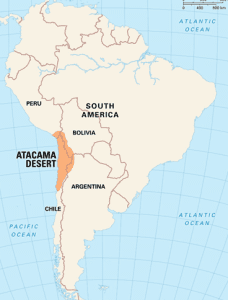TAG: GS 3: SCIENCE AND TECHNOLOGY
THE CONTEXT: Researchers have made a groundbreaking discovery of microbial life thriving beneath the parched surface of Chile’s Atacama Desert, uncovering a rich biosphere buried 13 feet below ground.
EXPLANATION:
- This finding not only expands our understanding of extreme microbial habitats but also holds implications for astrobiology, particularly in the search for life on Mars.
Depth of Discovery
- Previous studies had identified microbial life in the Atacama Desert down to depths of 2.6 feet, but the recent discovery marks the deepest finding to date, reaching 13 feet underground.
- This newly found microbial community resides in the bone-dry Yungay Valley and is completely isolated from the surface environment, indicating a unique and unexplored ecosystem.
Composition and Characteristics
- Dominated by Actinobacteria, the microbial community at depths of 6.6 to 13 feet parallels other extreme environments like the Arctic and hot springs.
- Actinobacteria are known for their resilience and adaptability to harsh conditions, suggesting their suitability for survival in the extreme environment of the Atacama Desert.
- Additionally, Firmicutes bacteria, capable of withstanding high salt concentrations and anaerobic conditions, were discovered between 0.8 and 2 inches deep.
Methodology and DNA Analysis
- Researchers employed a novel method to differentiate between intracellular DNA from living microbes and extracellular DNA from dead cells, providing more accurate insights into microbial diversity.
- Soil samples were extracted from the Yungay Valley, and DNA fragments were analyzed to identify microbial species and understand their distribution across different depths.
Environmental Factors Influencing Microbial Life
- The transition zone from clay-rich playa deposits to ancient river deposits coincided with the emergence of a stable microbial community.
- Actinobacteria likely colonized river deposits around 19,000 years ago and became buried beneath playa sediments over millennia.
- Microbes at depth may sustain themselves by extracting water from gypsum, a process reversible at high temperatures, suggesting a mechanism for survival in the arid environment.
Astrobiological Implications
- The Atacama Desert serves as an analog for studying Martian conditions, where the surface is barren but may conceal subsurface microbial life.
- Gypsum deposits on Mars, similar to those in the Atacama Desert, could potentially serve as a water source for microbial communities, informing future Mars exploration missions.
Atacama Desert:
- The Atacama Desert is a desert plateau located on the Pacific coast of South America, in the north of Chile.
- Stretching over a 1,600 km (990 mi) strip of land west of the Andes Mountains, it covers an area of 105,000 km2 (41,000 sq mi), which increases to 128,000 km2 (49,000 sq mi) if the barren lower slopes of the Andes are included.
- The Atacama Desert is the driest nonpolar desert in the world, and the second driest overall, behind some specific spots within the McMurdo Dry Valleys.
- It is the only hot true desert to receive less precipitation than polar deserts, and the largest fog desert in the world.
- The area has been used as an experimentation site for Mars expedition simulations due to its similarities to the Martian environment.

Atacama Desert
Spread the Word
